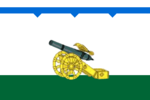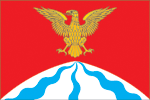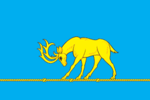This article includes a list of references, related reading, or external links, but its sources remain unclear because it lacks inline citations .(December 2024) |
 | |
| Proportion | 2:3 |
|---|---|
| Adopted | 22 December 1998 |
| Design | Red field with two horizontal stripes at the bottom, charged with the Coat of arms of Smolensk Oblast at the canton. |
| Designed by | G.V. Razhnëv |
The official flag ofSmolensk Oblast was adopted on 22 December 1998. the flag of Smolensk Oblast is a rectangular red cloth with a ratio of width to length 2:3 at the bottom are two gold-yellow stripes occupying 5 percent of the flag width and dividing the flag in width into three parts in a 6:2:1 ratio. Above the flagpole there is a shortened version of the coat of arms of the Smolensk Oblast - a shield with a cap occupying 45 percent of the width and 20 percent of the flag's length, and the vertical axis of the coat of arms divides the flag in a 1:4 ratio. The flag cloth can be framed with gold fringe.
On December 10, 1998, by Decision No. 179, the Regional Duma adopted the Law "On the Coat of Arms and Flag of Smolensk Region" No. 38-z of December 22, 1998. The law entered into force on December 30.




















